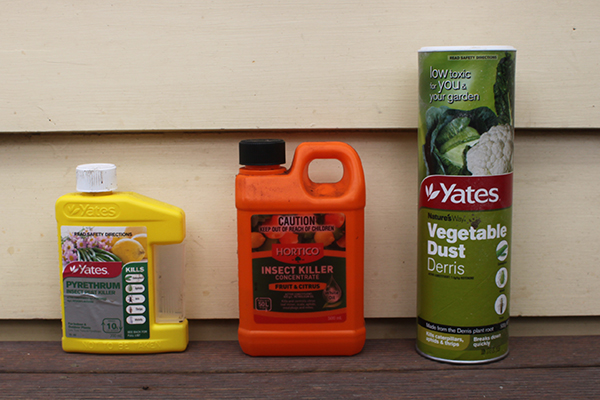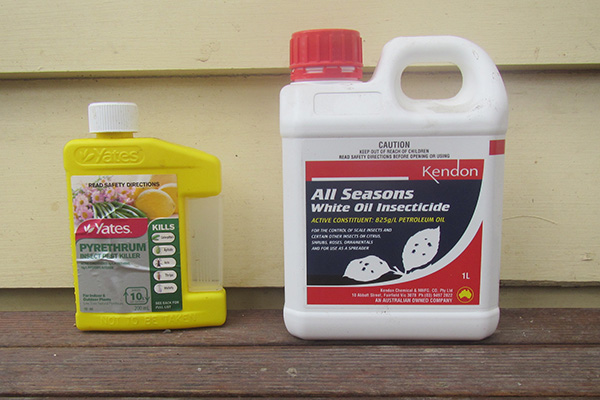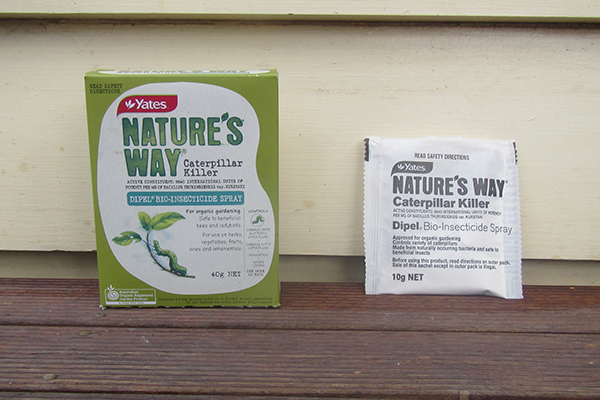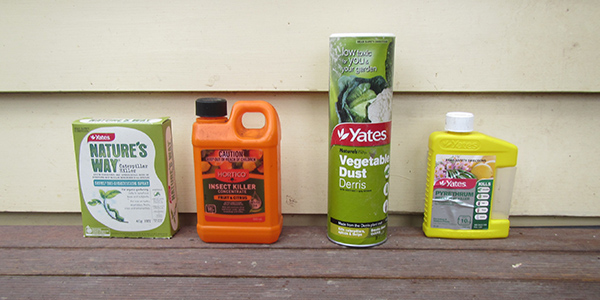This page is part of the “DEFEND” section of the Three Ds Pest Control program, which is a gradual three stage approach to protect vegetables from pests that is designed to minimise the use of pesticides. DEFEND is when you actively kill pests attacking your plants, but only with environmentally friendly methods and only after DETER methods have failed. For an overview of the Three Ds Pest Control program click HERE.
Note that only pesticides and control methods that I use or have used in the past are listed on this page. As such it represents only a small proportion of the insect pesticides that are available.
TARGET INSECTS: Caterpillars, aphids, and thrips.
TARGET CROPS: Brassicas (cabbages, cauliflowers, broccoli etc..) and other leafy plants.
The active ingredient in Derris dust is Rotenone, a natural compound that is found in several tropical and subtropical plants in Central and South America. It is effective against cabbage butterfly and I use it on Brassica seedlings when growing in seedling boxes and when first planted in the ground. However, it is water soluble, so it is best not to use it if rain is expected.
While considered an organic insecticide it is a broad-spectrum insect killer. Meaning that it will kill a wide range of insects, not just the ones eating your vegetables. As such should only be used sparingly.
TARGET INSECTS: Caterpillars, aphids, thrips, cherry slugs and ants.
TARGET CROPS: A wide range of vegetables, also suitable for fruit trees.
Pyrethrum is a natural insecticide that comes from the Chrysanthemum daisy. It is effective against a wide range of insects and, in lower doses, will act as an insect repellent. I have found it effective at killing aphid and whitefly infestations. While considered an organic insecticide it is a broad-spectrum insect killer. Meaning that it will kill a wide range of insects, not just the ones eating your vegetables. And as such should only be used sparingly

LEFT: Pyrethrum. CENTRE: White Oil. RIGHT: Derris Dust. All are what are considered organic pesticides. But note that they are also broad spectrum-insect killers, meaning that they are toxic to a wide range of insects including ones beneficial to your garden such as lacewings and ladybirds.
TARGET INSECTS: Scale, aphids, mites, and mealy bugs.
TARGET CROPS: Deciduous fruit trees, citrus trees and rose bushes.
White Oil works by blocking the breathing pores of insects, causing suffocation and death. I mainly use it to kill scale on citrus trees. The active ingredient is petroleum oil, though you can make up your own white oil using sunflower oil and detergent, though note that I have never made it myself.
TARGET INSECTS: Scale, cherry slugs, and ants.
TARGET CROPS: Citrus, cherry, and pear trees.
While white oil is effective at killing adult scale it is less effective at killing juvenile scale and ants. When it comes to killing scale it is also important to kill any ants on the tree the scale is on as ants farm scale to collect the honeydew that they produce. To maximise honeydew production the ants actively protect the scale from predictors and move juvenile scale form one tree to another.
Not only is this White oil and pyrethrum combination more effective at killing scale than just white oil it is also an effective at killing cherry slugs on pear and cherry trees.
To make it up mix both the recommended dose (if will vary depending on the how concentrated each product is) for the White Oil and Pyrethrum in the same amount of water and spray as per directions.

Used in combination Pyrethrum and White Oil is highly effective controlling scale on citrus trees. It is also effective against cherry slugs on cherry and pear trees.
TARGET INSECTS: Cherry slugs.
TARGET CROPS: Cherry and pear trees.
To apply tip some lime powder (commonly used by gardeners to reduce the acidy of soil) into a bucket. Then take a garden trowel and flick small amounts of the lime over the tree so that it falls on the leaves as a light dust. The powder desiccates the skin of the cherry slugs, causing them to shrivel and die. You can also use sieved wood ash in place of lime.
Apply when the cherry slugs begin to become active in mid spring. Repeat the dusting if there are still signs of cherry slugs, though normally one application is enough.
The downside of regularly dusting your trees with lime is that, as lime is alkali, it can raise the ph. of the soil below the trees.
TARGET INSECTS: Caterpillars
TARGET CROPS: Any leafy vegetables susceptible to attack by caterpillars.
Bacillus thuringiensis is a bacterium that only attacks leaf eating caterpillars, leaving predatory insects unharmed. It can do this because it is effectively a stomach poison. If a caterpillar eats part of a leaf that has been sprayed with Bacillus thuringiensis it will also ingest some of the bacteria. The caterpillar usually stops eating within hours and is dead within two or three days.
While there are a range of caterpillars that this bacterium will attack, I use it mainly for killing cabbage butterfly, which specializes in attacking plants of the Brassica family (cabbage, cauliflower, broccoli etc…) While it is slower acting then Derris dust it seems to last longer on the plants and leaves predatory insects unharmed to do their work.
In treating Brassica plants against cabbage butterflies I generally use Derris dust on the young seedlings in their seedling boxes and when they are first planted out. But once established in the garden I switch to Bacillus thuringiensis. The instructions on the Dipel packet say spray weekly, but I generally find that two sprayings are enough.





